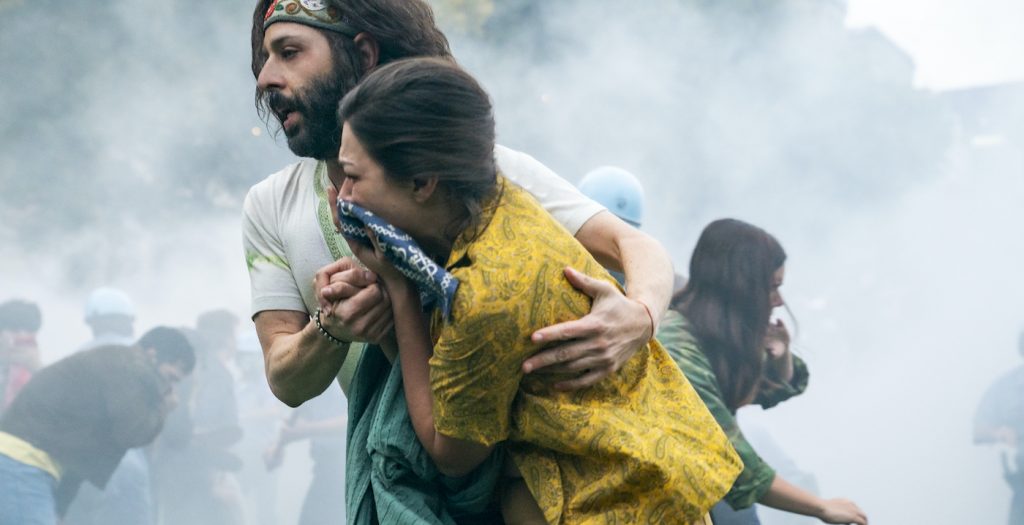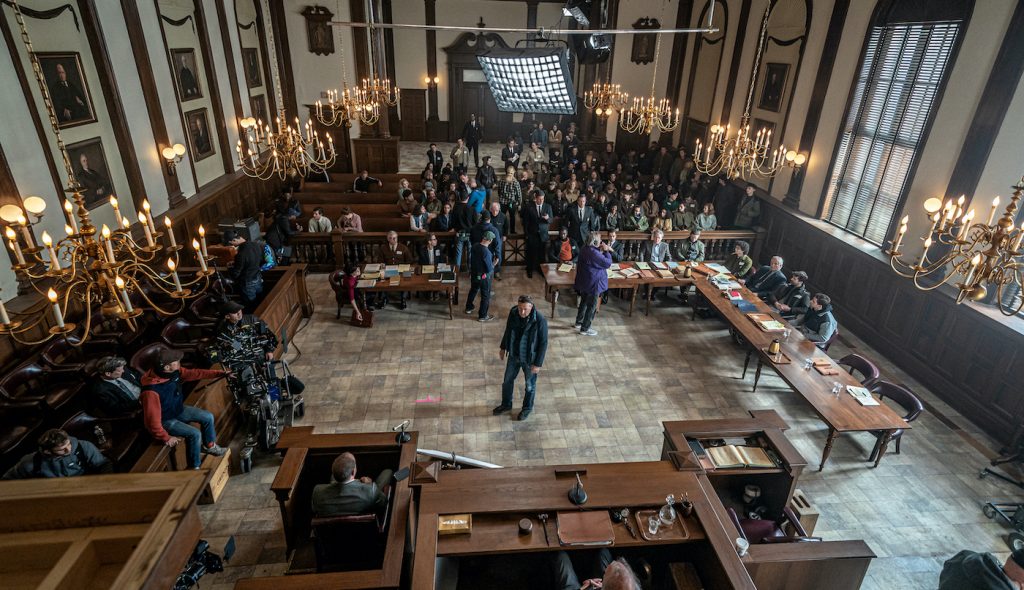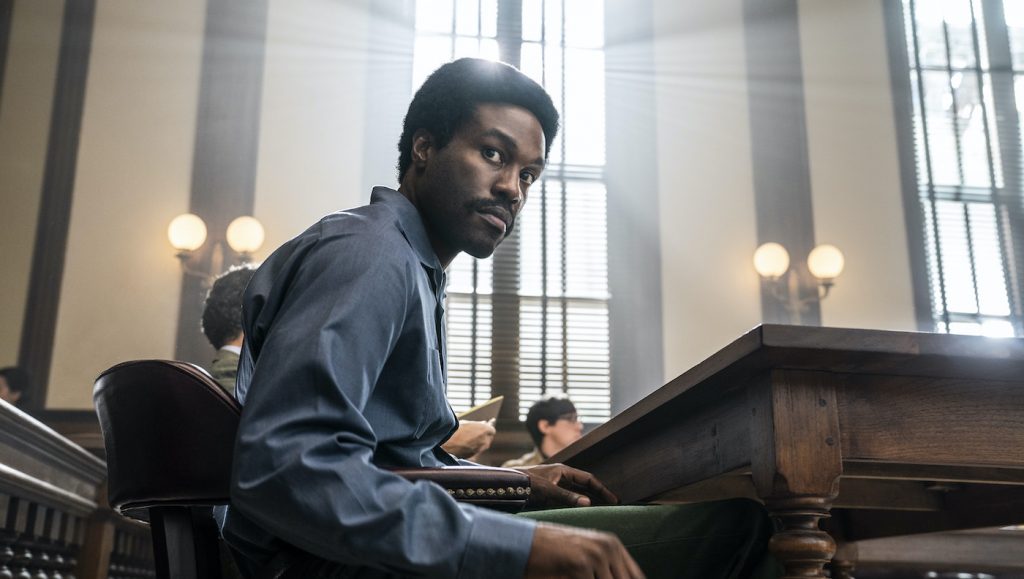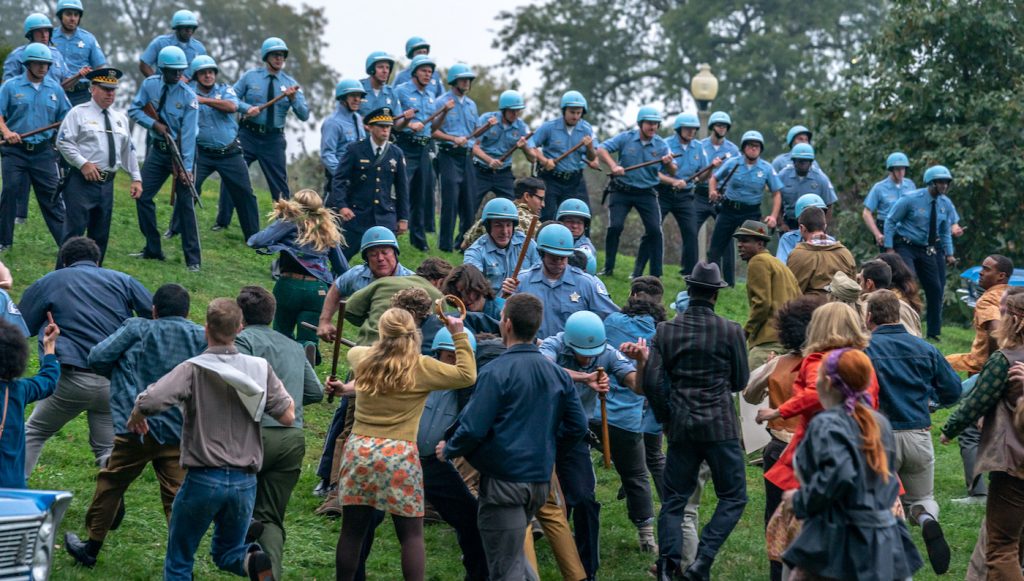DP Phedon Papamichael on Designing for Dialogue in Aaron Sorkin’s “The Trial of the Chicago 7”
Aaron Sorkin is well-known for his densely-packed dialogue, and The Trial of the Chicago 7, his retelling of the 1969 trial that saw counter-culture luminaries like Abbie Hoffman and Bobby Seale tried for conspiracy and inciting a riot, the writer-director is true to form. The film, which debuts on Netflix on October 16th, swerves between the trial and the defendants’ memories, to revisit what each of the seven accused was doing the day the police went after previously peaceful protestors outside the 1968 Democratic National Convention.
The trial dragged on for months, but in Sorkin’s snappy depiction (featuring an ensemble cast including Sacha Baron Cohen as Abbie Hoffman, Mark Rylance as defense lawyer William Kunstler, Joseph Gordon-Levitt as prosecutor Richard Schultz, and Yahya Abdul-Mateen II as Bobby Seale, the most falsely accused of the group) a limited budget and a short shooting window meant that cinematographer Phedon Papamichael had to get creative. The Credits sat down with the Papamichael to learn about his process working with a director known for his dialogue, how he kept a courtroom setting visually interesting and recreated a documentary feeling at the riots themselves.
How did you come to be involved in the project?
Stuart Besser [with whom I worked on 3:10 to Yuma] made the introduction. We had a ten-minute interview where Aaron literally said, I’m going to rely heavily on you, and I’m just excited that you’re doing this. And then he left and I said, Stuart, hold on — so how does it really work? He goes, well, he knows what he wants, doesn’t really want other stuff, but you’re going to be the one telling him what the other stuff is. So we did it. It was a short movie, low-budget, and complicated more so than anticipated, because we had a lot of extras. You know, the riots at the original event had 10,000 people. We had like two hundred extras in the park. At least we got to shoot at the actual location. We had footage from Medium Cool where [director] Haskell Wexler actually covered the actual event. We were able to integrate some of his footage and it gave us visual references, how much tear gas was present, that kind of thing.

A Sorkin production, of course, is known for its fast, information-dense dialogue. But what’s the process like working with the director on the lighting and visuals?
He’s the first one who says, ‘I so heavily rely on the cinematographer handling the visual interpretation.’ Everything is about the word and the page and in terms of how to break it down, shots, and what is required technically, is really abstract to Aaron. He literally closes his eyes when we’re shooting. I mean, of course he sits at the monitor, but it’s all about the rhythm, the language. He says, I need an insert of the bottle hitting the ground in the riots because it’s referred to [in the dialogue], and it also triggers where our hero is trying to stop the crowd. And so he has very specific visual cues that are important to him in terms of his story beats.
Other than that, when it comes to covering a defendant, prosecutor, the judge, the jury, the Black Panthers, he really doesn’t know what’s required in terms of coverage, and he’s the first one to say it’s no problem. It’s just a different relationship, working with a director who is not involved as much in [the visuals]. And I mean, my job as a cinematographer is to to know, whether or not a guy can express it technically, what’s in his head, the story he wants to tell, what’s important for him to see. And then it’s my job to get as close as possible to that.

So much of the action takes place in court. How did you approach these scenes?
What we did was a very hard film in terms of 60% taking place in the courtroom. And of course, the writing is non-linear. You enter and exit the court continuously. You’re sometimes gone for three seconds, and then you come back to the courtroom, but you don’t even come back to the same witness, you come back to a witness who’s in the chronological timeline prior to the witness who triggered you coming out of the courtroom to a vignette.
I made this whole spreadsheet of the courtroom. The trial actually took place from September 24th to February 18th, and I wanted to show visually that this thing went on forever. So I broke down all the courtroom days that were not really scripted — there are only four occasions where there’s a date. But with the script supervisor, we created this breakdown, and then I went through it and I assigned moods for the trial because I was concerned about being visually stagnant. I didn’t want to get lazy and just default into courtroom lighting, you know, sunbeams coming through. I thought, well, it would be appropriate, let’s say, when Abbie Hoffman is on the witness stand and he says, ‘give me a moment. You know, I’ve never been on trial for my thoughts before,’ that that should feel a bit moodier than the opening of the trial, when they were feeling like the whole world was watching and there was some enthusiasm and some positivity going into it. Of course, then it turned sour on many occasions. For the verdict, we went sunny again with hard beams, because Tom Hayden stands and reads all the names, they were in white prison outfits, and he sort of glows like this angelic, heroic figure.
How did you deal with lighting to create the impression of different moods and weather?
It was kind of randomly just deciding what the moods would be, but tracking because we were low-budget, and we had to block shoot, which means we often had to shoot four scenes in one direction because I didn’t have the crowd. We built the courtroom in this abandoned schoolhouse in Paterson, New Jersey. So I said, I need to completely control this environment from a lighting standpoint. I had to create a setup, lighting-wise, outside the bay windows where I could switch it over really quickly, so I built this gigantic box and sealed all the windows in, which made me daylight- and weather-independent. I had units in there so that I could even the balance, change the color temperature, plus sky panels that could quickly and remotely change, or turn around to create direct light.

Was it challenging to set up the scenes of the protests-turned-riots?
Aaron is very precise in terms of the rhythm and the pacing of the film, which for a cinematographer also means it’s pointless to design some big cinematic shot, let’s say, of the rioters when they enter the bridge and walk towards the [police], who have these jeeps with barbed wire and armored vehicles. It’s like he says, I only need three seconds of that. And I wanted to capture the energy of the documentary footage that we were referring to in terms of tear gas and a hand-held mode. So I would literally just send off my two cameramen and say, just make a documentary about this moment, get in the crowd, walk with them. Also, help mask the fact that we only have two hundred extras, and the actual event had 10,000 people. Then the tear gas helped because we were actually shooting in the same location, but of course, it’s 40 years later and we don’t have money for effects, so I had to avoid the modern architecture that’s now surrounding Grant Park. But it was great having the hill, having the statue, and shooting at the exact location where it took place helped geographically tie the [events] together.

The events turn on conversations at the Conspiracy Office, where it’s also always night. How did you get that set up?
One good example in the Conspiracy Office is when [lawyer] Kunstler is doing the mock interrogation with Tom. It’s basically two people, but they’re all there in the room and Aaron goes, I don’t really need any shots on anybody else. I go, you’ve got ten actors standing there and listening to it — we do have to feel their presence. I understand this is the counselor doing this mock trial with Tom, and that’s what the scene is about. But Abbie Hoffman then has this scene where he goes, ‘that’s what [Tom] meant when he said to let the blood flow all over the city. He meant our blood. He always does that. He doesn’t use pronouns.’ And Tom responds, ‘put him in the chair.’ That’s a key moment. So my job is to give Aaron what he needs for this. So I put the actors against the wall, put them in the dark and you feel them. That’s why I use these wider lenses and I’m also doing close ups. I get a sense of the space and the room. And then also with lighting, I can emphasize that on Sunday morning, Tom is much brighter. It’s a way of giving Aaron what’s important to him, but also telling, I think, the visual story that is necessary in terms of the fact that they were all there and participating, even if they don’t have lines.
For more on The Trial of the Chicago 7, check out these interviews:
Alan Baumgarten on Editing Aaron Sorkin’s Rapid-Fire Dialogue in “The Trial of the Chicago 7”
Aaron Sorkin on Writing & Directing his Timely “The Trial of the Chicago 7”
Featured image: The Trial of the Chicago 7. Yahya Abdul-Mateen II as Bobby Seale, Kelvin Harrison Jr as Fred Hampton, Aaron Sorkin as Writer / Director, Mark Rylance as William Kunstler, Eddie Redmayne as Tom Hayden, Sacha Baron Cohen as Abbie Hoffman, Jeremy Strong as Jerry Rubin, John Carroll Lynch as David Dellinger in The Trial of the Chicago 7. Cr. Niko Tavernise/NETFLIX © 2020



